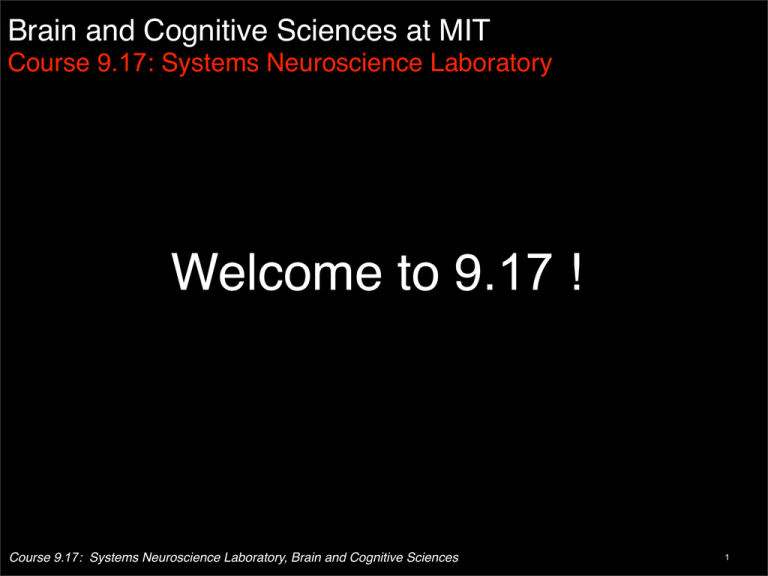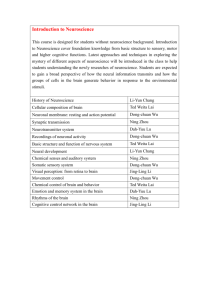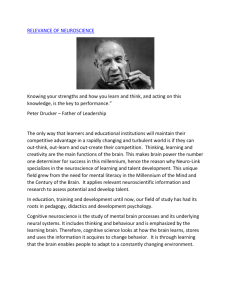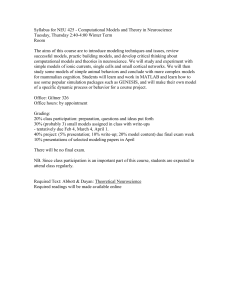
Brain and Cognitive Sciences at MIT
Course 9.17: Systems Neuroscience Laboratory
Welcome to 9.17 !
1
Course 9.17: Systems Neuroscience Laboratory, Brain and Cognitive Sciences
1
Image courtesy of EMSL on Flickr. CC BY-NC-SA.
• 100 billion computing elements
• solves problems not soluble by any previous machine
• requires only 20 watts of power!
Course 9.02:
Keyand
algorithms
are still classified
Systems Neuroscience Laboratory, Brain
Cognitive Sciences
2
2
Class 1: overview
•
•
•
•
Goals, syllabus, grading, expectations, etc.
Overview of methods used to study the brain
Discussion on animals in research
Lab tour and safety discussion
Course 9.17: Systems Neuroscience Laboratory, Brain and Cognitive Sciences
3
Class 1: overview
•
•
•
•
Goals, syllabus, grading, expectations, etc.
Overview of methods used to study the brain
Discussion on animals in research
Lab tour and safety discussion
Course 9.17: Systems Neuroscience Laboratory, Brain and Cognitive Sciences
4
Expectations
What you should expect of us:
What we expect of you:
•
•
•
•
•
•
•
•
•
•
Prepared to teach topic
Eager to help with techniques
Eager to answer questions
Available outside of class
Feedback on your work
Be prepared for each lab
Eager to learn techniques
Ask questions!
Seek help!
Work submitted on time
Course 9.17: Systems Neuroscience Laboratory, Brain and Cognitive Sciences
5
Adding and dropping 9.17
Adding 9.17: Students on the wait list that attend the first week will have priority if a spot becomes
available by the start of week 2. No adds will be allowed after the end of week 2, and week 2 quizzes
and attendance will count in the final grade for ALL students.
Dropping 9.17: We understand that you may decide to drop the course for any reason. However,
because space is limited we kindly ask that you let Susan Lanza in the BCS office know of your drop
by the start of week 2. If you do not do this or decide to drop the course at a later date, you may get
on the wait list for the course in a future year, but first-time entrants on the wait list will get priority.
Listener status for 9.17: Listener status is currently not allowed in 9.17.
Course 9.02: Systems Neuroscience Laboratory, Brain and Cognitive Sciences
6
Brain and Cognitive Sciences at MIT
Course 9.17: Systems Neuroscience Laboratory
Documents you have been given today:
9.17 Lab handbook (Lab Manual)
Your 9.17 Lab notebook (empty)
Course 9.02: Systems Neuroscience Laboratory, Brain and Cognitive Sciences
7
Brain and Cognitive Sciences at MIT
Course 9.17: Systems Neuroscience Laboratory
Components of your 9.17 grade:
- quizzes (11) -- only best 10 will count
- lab reports (2)
- lab notebook (11) -- only best 10 will count
- Matlab tutorials
- in-lab participation
- in-recitation participation
Course 9.02: Systems Neuroscience Laboratory, Brain and Cognitive Sciences
8
Brain and Cognitive Sciences at MIT
Course 9.17: Systems Neuroscience Laboratory
Each week:
Monday lecture: background on lab
Tues recitation: prepare by reading one paper
Wed laboratory: prepare by reading protocol, background readings,
prepare your lab notebook
Quiz given at start of each lab *:
- lecture material
- recitation papers and questions
- lab preparation material
( * there are 11 quizzes, but you get to throw one out! )
Course 9.02: Systems Neuroscience Laboratory, Brain and Cognitive Sciences
9
Brain and Cognitive Sciences at MIT
Course 9.17: Systems Neuroscience Laboratory
Lab reports:
- You will learn how to write a short scientific paper.
- A description of what is expected and how we will provide
feedback and grading of y our lab reports is on the class web
site.
- Because you will typically work in teams of 2-3 in each lab, the
data in each lab report will often be identical. However, W E
EXPECT EACH OF YOU TO WRITE YOUR OWN LAB
REPORT. Duplicate sentences or paragraphs in lab reports are
considered to be a form a plagiarism and, as MIT students, you
already know that this is extremely unethical. If t his, or a ny
other form of plagiarism (e.g. sentences copied from references
without citation) is apparent in y our lab report, the report will
receive a grade of zero, and you may be referred to the MIT
Committee on Discipline.
The primary grading criteria for the lab reports are:
1) Proper organization (Is the proper material in the proper section?)
2) Clarity (Are the key points obvious? Is it easy to read and understand?)
3) Conciseness (Are there wasted sentences? Too much redundancy?)
4) Quality of data and figures (Are data figures appropriate and clear?)
Detailed grading criteria will be posted online and you will receive
Course
9.02: Systems
Neuroscience
and Cognitive
Sciences
feedback
from
us on Laboratory,
first labBrain
report
(chance
to revise).
10
Brain and Cognitive Sciences at MIT
Course 9.17: Systems Neuroscience Laboratory
Lab notebook:
•Goal is to teach you how do document your experimental
work
1. Outline protocol for lab BEFORE your lab session (you will be asked
to leave the lab until your notebook shows your experimental plan)
2. Make all notes, data, and drawings regarding your lab in your
notebook
3. Turn in a copy of your lab notebook pages for the lab when you leave
the lab.
Course 9.02: Systems Neuroscience Laboratory, Brain and Cognitive Sciences
11
Brain and Cognitive Sciences at MIT
Course 9.17: Systems Neuroscience Laboratory
9.17 Handbook:
- Overall course grade.
- quizzes, lab reports (2), in-lab participation, Matlab
tutorials, recitation participation, lab notebook
- FAQs: missed / late policies, office hours, etc.
- Lots of advice and guidance on how to prepare your lab
reports, etc.
Course 9.02: Systems Neuroscience Laboratory, Brain and Cognitive Sciences
12
!
Brain and Cognitive
Sciences at MIT !
Course 9.17: Systems
!
Neuroscience Laboratory
!
Final grade sheet
(in 9.17 handbook)
!
!
!
!
Student:
Section:
Primary TA:
Total 9.17 points:
Max 9.17 points:
Final letter grade:
Jane Doe
Wed
TA name
0 (Sum
1000
>900 = A, >800 = B, >700 = C, >600 = D
Quizzes- Best 10 of 11
No.
1
2
3
4
5
6
7
8
9
10
11
Topic
Lab Notebook - Best 10 of 11
Points
of Max
30
30
30
30
30
30
30
30
30
30
30
Practical Lab (both)
C. Anatomy (Tye)
Cockroach (Tye)
Frog (DiCarlo)
Rat Phys. (Tye)
Rat Phys. (Tye)
Matlab (DiCarlo)
Fly (DiCarlo)
Fly (DiCarlo)
Fly (DiCarlo)
Fly (DiCarlo)
Total quiz points:
0
300
Matlab projects
No.
0
1
2
3
Topic
Plotting
Spike detection
Movie creation
Data analysis
of six boxes below)
No.
Topic
1
2
3
4
5
6
7
8
9
10
11
Points
of Max
10
10
10
10
10
10
10
10
10
10
10
Practical Lab
Classic Anatomy
Cockroach
Frog
Rat Physiology
Rat Physiology
Fly Wet Lab I
Fly Movie Design
Fly Wet Lab II
Fly Data Analysis
EEG/MRI
Total notebook points:
0
100
Research reports
Points
of Max
10
20
30
40
No.
Topic
1 Rat Phyisology
2 Fly Vision
Points
Total report points:
of Max
200
200
0
400
Free extension used?:
!
!
Total Matlab points:
0
100
Lab participation
Recitation Participation
No. Topic
1 Recitation
Total particip. points:
No.
Points
of Max
40
0
!
Course 9.02: Systems Neuroscience Laboratory, Brain and Cognitive Sciences
!
40
1
2
3
4
Topic
Anatomy
General Phys.
Barrel Phys.
Fly Vision
Total particip. points:
Points
of Max
15
15
15
15
0
60
Class 1: overview
•
•
•
•
Goals, syllabus, grading, expectations, etc.
Overview of methods used to study the brain
Discussion on animals in research
Lab tour and safety discussion
Course 9.17: Systems Neuroscience Laboratory, Brain and Cognitive Sciences
14
Genes and
molecules
Cellular
components
Neurons
Interaction
of many
neurons
Behavior
Introduction
The fundamental goal of neuroscience
is to understand the brain mechanisms
that give rise to behavior
“Consciousness”
“Theory of mind”
“Understanding causality”
“Reasoning”
“Learning”
“Emotion”
“Motivation”
“Language”
“Memory” “Decision making”
“Perception”
“Recognition”
Course 9.17: Systems Neuroscience Laboratory, Brain and Cognitive Sciences
“Intent”
“Action”
15
Scene “understanding”
Car
Person
Building
Tree
Sign
Lamp post
...
Courtesy of Tomaso A. Poggio. Used with permission.
From MIT Street Scenes Database (Courtesy of Tommy Poggio)
16
Serial snapshot analysis
scene “understanding”
Courtesy of Tomaso A. Poggio. Used with permission.
17
Serial snapshot analysis
scene “understanding”
Courtesy of Tomaso A. Poggio. Used with permission.
From “Street Scenes” Database (Courtesy of Tommy Poggio)
18
scene “understanding”
Serial snapshot analysis
Snapshot (core) object detection
•
•
•
•
•
Fast (~200 msec)
Feels effortless
Large number of objects
No pre-cueing needed
Tolerant to variation
Our mission: Understand how the brain constructs a neuronal
representation that underlies core object detection
19
The ventral visual processing stream
Dorsal visual stream
Decision
and action
Memory
Ventral visual stream
Motter, BC, and VB Mountcastle. "The Functional Properties of the Light-Sensitive
Neurons of the Posterior Parietal Cortex Studied in Waking Monkeys: Foveal
Sparing and Opponent Vector Organization." The Journal of Neuroscience
Courtesy of Elsevier, Inc., http://www.sciencedirect.com. Used with permission.
1, no. 1 (1981): 3-26. Available under Creative Commons BY-NC-SA.
Houses critical circuits and
resulting neuronal representations
for object recognition.
We can study those
representations at the
level of neuronal spikes.
20
The ventral visual processing stream
Ventral visual stream
Courtesy of Elsevier, Inc., http://www.sciencedirect.com. Used with permission.
21
The ventral visual processing stream
Ventral visual stream
Courtesy of Elsevier, Inc., http://www.sciencedirect.com. Used with permission.
Image: Kimberly Brown-Azzarello. Flickr. CC BY-NC.
22
The ventral visual processing stream
Ventral visual stream
Courtesy of Elsevier, Inc., http://www.sciencedirect.com. Used with permission.
Image: Kimberly Brown-Azzarello. Flickr. CC BY-NC.
23
The ventral visual processing stream
Ventral visual stream
Courtesy of Elsevier, Inc., http://www.sciencedirect.com. Used with permission.
Image: Kimberly Brown-Azzarello. Flickr. CC BY-NC.
Key cortical algorithms are unknown; remarkable potential
24
Our primary tools:
Behavior
Physiology
Computation
L3
thresh/sat
Learning
Rate
Trace
“Temp. Adv.”
“Auto-reset”
...
number of filters
thresh/sat
norm strength
Learning
normalization
neighborhood
kernel
size
n. of filters
L1
Intervention
norm strength
normalization
neighborhood
L2
Imaging
thresh/sat
norm strength
Rate
Trace
“Temp. Adv.”
“Auto-reset”
...
Learning
normalization
neighborhood
kernel
size
Rate
Trace
“Temp. Adv.”
“Auto-reset”
...
number of filters
input
kernel
size
Collage images © source unknown. All rights reserved. This content is excluded from our
Creative Commons license. For more information, see http://ocw.mit.edu/fairuse.
.
Image: Kimberly Brown-Azzarello.
Flickr. CC BY-NC.
25
Emotion: the basis of motivated behavior
• Emotions = evaluation of environment
Motivation = response to environment
(Kuhl, 1986)
• Emotions provide a system to evaluate
environmental stimuli and motivate a
behavioral response
(D’Amasio, 1994;
Tooby & Cosmides, 1990)
• Amygdala critical for assigning
motivational significance to
environmental stimuli
(Brown & Schafer 1888; Kluver & Bucy, 1937)
• Amygdala evolutionarily conserved;
dubbed “reptilian brain (Maclean, 1969)
26
Neural basis of
motivated behavior
DAPI
BLA
CeM
EYFP
Figure'1,'Tye'et'al.
CeL
CeM
BLA
CeL
h
g
on
***
Total'Time
in'Center'(s)
off
off
0
ChR2:BLA'Soma'(n=7)
on
***
**
50
100
light'on
light'on
light'off
light'on
light'off
light'off
off
on
0
off
***
EYFP:BLA9CeA'(n=9)
0.07386
20
0.1764
0.1530
N/A
30
0
0
40
0.3216
0.0433
0
50
100
150
ChR2:BLA9CeA'(n=8)
R
off
Extinction resistance
50
***
ChR2:'BLA'Somata'(n=7)
Reinforcement omission (n ! 32/330; 10%)
r2
p
Extinction only (n ! 47/330; 14%)
r2
p
Maint. only (n ! 4/330; 1%)
Empty in Maint. (n ! 17/330; 5%)
r2
200
EYFP:'BLA9CeA'(n=9)
ChR2:'BLA9CeA'(n=8)
250
708.1'cm
c
open
light'off
b
0.5
630.3'cm
light'on
15'min
1
Probability'of'
Open'Arm'Entry
838.2'cm
light'off
Bare'fiber
over'BLA
Beveled
cannula
over'CeA
Population
Time'in'Open'Arm'(s)'
Behavior
Beveled
cannula
over'CeA
Figure 8. A subpopulation of BLA neurons that encoded port entries in the presence
predicts response intensity and extinction resistance. A, A representative BLA neuron t
absent during maintenance, but developed a phasic inhibition upon port entries when s
condition including the 22 neurons that displayed a similar response profile to that of t
is present, did not respond upon port entries when sucrose was absent during maintena
showing normalized activity in each port entry condition for neurons with response prof
recorded per rat was significantly correlated with each rat’s response intensity (E) and
0
0
N
in'Center'(s)
ChR2:BLA9CeA
18'min
Table 2. Linear regression scores and p values for correlations between all ne
closed
a
Circuit
3'min
EYFP:BLA9CeA ChR2:BLA'Soma
ChR2:BLA9CeA
What neural circuits mediate
motivated behaviors?
What processes underlie
motivated behavior?
Cell
EYFP:BLA9CeA
How do different cell types
contribute to distinct
aspects of behavior?
124 • J. Neurosci., January 6, 2010 • 30(1):116 –125
2:'BLA'Soma
How can the balance of
synaptic input influence
behavior?
Synapse
27
0
Why do we care about emotion and
motivation?
Anxiety
Positive Emotion
Motivated to Seek
Rewards
Negative Emotion
Motivated to Avoid
Punishment
Addiction
Depression
28
Genes and
molecules
Cellular
components
Neurons
Interaction
of many
neurons
Behavior
Introduction
The fundamental goal of neuroscience
is to understand the brain mechanisms
that give rise to behavior
“Consciousness”
“Theory of mind”
“Understanding causality”
“Reasoning”
“Learning”
“Emotion”
“Motivation”
“Language”
“Memory” “Decision making”
“Perception”
“Recognition”
Course 9.17: Systems Neuroscience Laboratory, Brain and Cognitive Sciences
“Intent”
“Action”
29
Genes and
molecules
Cellular
components
Neurons
Level
Functions investigated
Preparations
Techniques
Molecular
neuroscience
- Channel function
- Signaling cascades
- Neurotransmitter processing
- Modifications to above:
(development, memory)
-DNA solutions
-Protein solutions
-Cell fractions
-Cell cultures
- Brain slices
- transgenic animals*
- Xray crystallography
- DNA and protein sequence analysis
- in situ hybridization
- genetic manipulations
-models / computation
- neurotransimission
- signal integration
- neuronal plasticity
- neuronal development
- Cell cultures
- Isolated nerve
- Brain slices
- detailed, simulated neurons
- transgenic animals*
- electron microscopy
- chemical manipulations
- intra-cellular electrophysiology
- immunohistochemistry
- two-photon microscopy
-models / computation
- system architecture
- system connectivity
- neuronal signaling
- neuronal transfer functions
- neuronal coding of information
- neuronal computation
- links between neuronal
properties and behavior
- Brain slices
- invertebrates
- anesthetized vertebrates
- awake vertebrates
- awake,non-human primates
- simulated neuronal networks
- transgenic animals*
- gross anatomy, histology
- immunohistochemistry
- tract tracing
- extra-cellular electrophysiology
- intra-cellular electrophysiology
- multi-unit electrophysiology
- chronic electrophysiology
- electrical microstimulation
- pharmacological stimulation/inhibition
- brain lesions
- intrinsic signal imaging
- animal behavior and psychophysics
- models / computation
- Perception
- Motor control
- Memory
- Decision/reasoning
- Language
- Consciousness?
- human subjects
- simulated brain processes
- human psychophysics
- behavioral observations
- functional MRI
-models / computation
(DNA, proteins,
transmitters)
Cellular
neuroscience
(whole neurons)
Systems
neuroscience
(interactions of
groups of neurons)
Interaction
of many
neurons
Cognitive
neuroscience
Behavior
(emergent, complex
behavior)
Course 9.17: Systems Neuroscience Laboratory, Brain and Cognitive Sciences
30
Level
Functions investigated
Preparations
Techniques
Systems
neuroscience
- system architecture
- system connectivity
- neuronal signaling
- neuronal transfer functions
- neuronal coding of information
- neuronal computation
- links between neuronal
properties and behavior
- Brain slices
- invertebrates
- anesthetized vertebrates
- awake vertebrates
- awake,non-human primates
- simulated neuronal networks
- transgenic animals*
- gross anatomy, histology
- immunohistochemistry
- tract tracing
- extra-cellular electrophysiology
- intra-cellular electrophysiology
- multi-unit electrophysiology
- chronic electrophysiology
- electrical microstimulation
- pharmacological stimulation/inhibition
- brain lesions
- intrinsic signal imaging
- animal behavior and psychophysics
- models / computation
(interactions of
groups of neurons)
Course 9.17: Systems Neuroscience Laboratory, Brain and Cognitive Sciences
31
What is the right tool for the job?
Behavior (psychophysics)
Brain
3
2
Map
1
Column
0
Layer
Neuron
Dendrite
Synapse
MEG + ERP
2-Deoxglucose
Spatial resolution (log mm)
Spatial and temporal resolution
fMRI
Optical imaging
PET
Gross
anatomy
Lesions
-1
-2
-3
Extracellular electrophysiology
Patch clamp electrophysiology
Light Microscopy
-4
-3
-2
Milisecond
-1
0
Second
1
2
3
4
Minute Hour
5
6
7
Day
Temporal resolution (log seconds)
Image by MIT OpenCourseWare.
Course 9.02: Systems Neuroscience Laboratory, Brain and Cognitive Sciences
32
Use of animals in this class: f animals
• It is not possible to study the nervous system without handling actual
neural tissue. Thus, several of the classes will use animals (rats, frogs,
cockroaches, flies).
• We have made every attempt to reduce the number of animals used in
this course. Several labs use simulations instead of animals.
• All animal procedures are in accordance with NIH guidelines are
approved by MIT’s Committee on Animal Care.
• We will have a presentation on the use on animals in research and
teaching from an MIT veterinarian.
• If you are uncomfortable with the use of animals, please contact one of
us immediately after this introduction (TODAY).
Course 9.17: Systems Neuroscience Laboratory, Brain and Cognitive Sciences
33
Class 1: overview
•
•
•
•
Goals, syllabus, grading, expectations, etc.
Overview of methods used to study the brain
Discussion on animals in research
Lab tour and safety presentation
• (Add/drop/etc. Please put your name on sign up
sheet before you leave. See Steve Russo for
this!)
Course 9.17: Systems Neuroscience Laboratory, Brain and Cognitive Sciences
34
MIT OpenCourseWare
http://ocw.mit.edu
9.17 Systems Neuroscience Lab
Spring 2013
For information about citing these materials or our Terms of Use, visit: http://ocw.mit.edu/terms.





